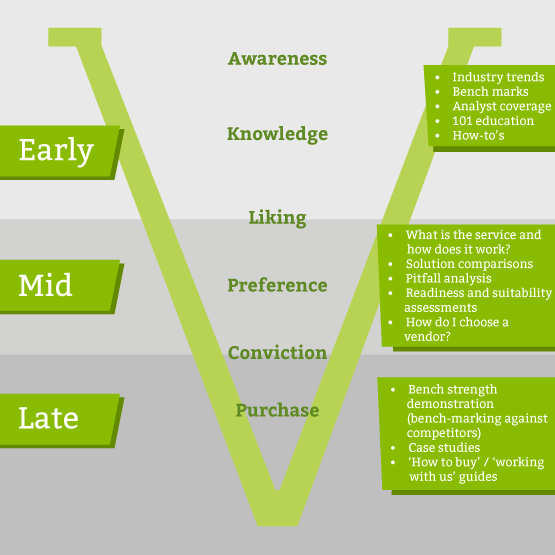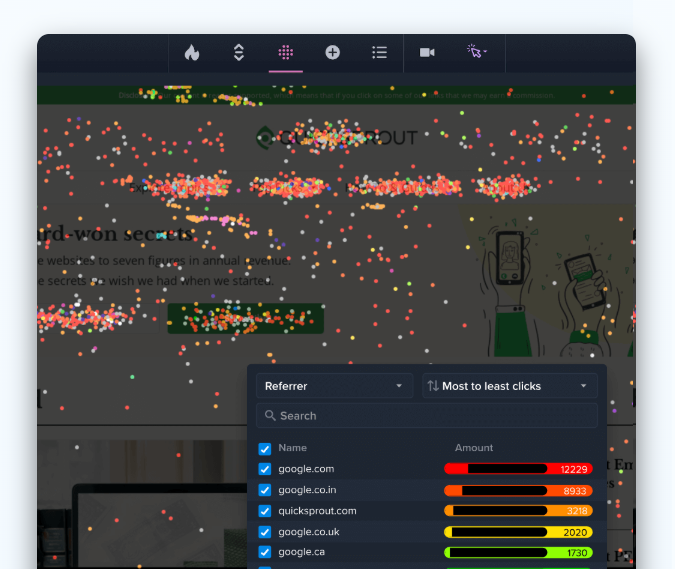As a savvy digital marketer, you probably already know the value of content marketing.
You probably also know it involves the creation and distribution of content in order to generate demand, bridging the gap between brand awareness and lead generation.
But are you aware that this process isn’t about the hard sell?
Some think that all marketing should push a sale. Nothing could be further from the truth.
Content marketing is about delivering valuable content and promoting yourself as a thought-leader within your vertical—a process that inspires brand loyalty and trust.
It makes sense, then, that you can’t succeed with just any content.
To get the most from content marketing, you’ve got to create content for each stage in the buyer’s journey, providing the right information at the right time to keep buyer interest high.
Let’s look at those stages now, and then I’ll show you 12 types of content that will help you get it done.
The Buyer’s Journey

How do we use content marketing to increase our conversion rates? The first step is to determine your customer’s buying cycle.
This is sometimes referred to as the buyer journey or the sales funnel, depending on the context, but they generally describe the journey from discovery to consideration and decision.
I like to take a leaf from the book of advertising and describe the process using the Hierarchy of Effects Theory, (but the AIDA principle will work just as well):
- Awareness – The potential customer realizes your product / service exists through advertising or word-of-mouth
- Knowledge – The potential customer begins to gain some superficial insight into the product or service, although they are not necessarily directly aware of your brand
- Liking – At this stage we begin to see an emotional response. Getting a potential customer to ‘like’ your product is an important step to put you above the competition (see number 4). How do you do this? By creating either rational or emotional appeal!
- Preference – Your potential customer should begin to develop personal preference for your product or service because of its outstanding USPs—and detachment from your competitors.
- Conviction – Things are heating up. Your potential customer has a desire to purchase your product or service. Now you just need to seal the deal!
- Purchase – Give yourself a pat on the back. You made a sale.
Mapping Content to Each Stage
So how do we generate conversions by mapping content to these stages?
Much like many other more traditional elements of the marketing mix, it all comes down to giving customers what they want. In this case, our content should be satisfying their pressing questions, regardless of which buying stage they’re at.
If we can map content to each of these stages we can cast a wide net, as it were, catching potential customers all the way from the top of the funnel down to the narrow final stages. Let’s look at how we do that.
Top of Funnel
Customers in the early stages of the buyer’s journey (the Awareness and Knowledge stages) aren’t necessarily aware that they have a problem—you don’t know what you don’t know, right? We should focus on:
Industry trends and benchmarks – Until they realize they are massively underperforming, potential customers may not realize they need your product / service to enhance their offering. OK, that’s the message for B2B markets. But it’s similar for B2C.
With industry trends and benchmarks, you can tell potential customers that they can run faster with running trainers instead of pumps, paint better with a brush that’s made of horsehair, learn Spanish quicker with help from an online tutorial, and so on.

This makes them aware that there’s a higher potential or better solutions than they’re currently enjoying, therefore creating desire.
Mid-Funnel
During the mid-stages we need to create an affinity between the potential customer and your product to service. Let’s look at types of content that can do this, fostering a preference for your offering over your competitors.
A solution to the problem – Our benchmarking content (top of funnel) has left the consumer suitably aware of their problem and their apparent need to seek your product / service. Now it’s time to offer a solution.
The best content here is that which describes your product / service and how it works. Provide a comparison of different options, offer a pitfall analysis and, to really place you above your competitors, suitability assessments.
Use a chart to show how each of your products compare, like this:

Or list reasons why you’re the best option for buyers, like this:

Source
You’d be amazed how explicitly listing the reasons why your product is right for your customer will increase your conversions.
Bottom of Funnel
During the later stages—the narrower end of the conversion funnel—we need to generate substantial buy-in.
You’ve spent time convincing your soon-to-be customer that they have a problem and that there is a solution out there. Now they need to be convinced that you are the right supplier for them and motivated to make the final purchase.
For that, you need to provide:
Credentials and decision support – How frequently do you see case studies or testimonials online? A lot. That’s because this type of content instils trust and brand loyalty, making the customer more likely to purchase.
Here’s an example from Microsoft:
As you can see, case studies provide a lot of proof that could build trust. But they aren’t you’re only option. You want to make the purchase process as easy as possible, so consider a ‘How to buy’ or ‘Working with us’ guide.
The Content Map
Okay, we’ve covered the stages of the buying cycle and the types of content that support each stage. Now let’s put it all this together.
Below I’ve put together a diagram that outlines the types of content you should be creating to market to users in specific stages of the conversion funnel—so you can easily map your content to the buyer’s journey.

So there you have it, 12 types of content to supercharge your conversion rates. Easy, right?
Now you
How do you map your own content to strengthen your sales funnel?
- Start by mapping out the questions people ask at each stage of your own buying cycle.
- Review existing content and determine whether it belongs in the top, middle or bottom of your funnel.
- Now look for gaps. Are there questions that you don’t provide answers for? Make a list of content pieces that need to be created to provide plenty of answers at each stage.
- Then get busy creating it.
Before long, you’ll have content for every stage of the buyer’s journey—and you’ll likely see the results in your bottom-line profits.
Author Bio: Paddy O’Neill
Marketing Consultant, Charity Trustee and coffee lover. Not necessarily in that order. I’m a senior marketing professional with strong design sensibilities, commercial acumen and an obsession with improving CX.





